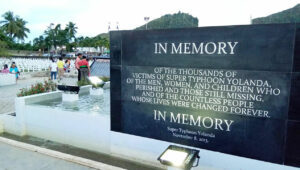ONE of the biggest lessons from Typhoon Haiyan, which struck central Philippines on Nov. 8, 2013, is that disaster management must involve communities from planning to rehabilitation, said a professor who has done studies on what is locally known as Super Typhoon Yolanda.
Maria Ela L. Atienza, a political science professor at the University of the Philippines, pointed out that the country already had the Disaster Risk Reduction and Management Act in 2010, but the law — intended to shift focus not just on disaster response but preparedness and mitigating threats — was not fully rolled out.
“We have the law,” she said on Tuesday over the Alerto Bangsamoro program of DXMS Radyo Bida in partnership with International Alert Philippines.
This, she said, spells out the responsibilities of the national and local governments as well as other agencies.
But even years post-Yolanda, Ms. Atienza said the country has yet to fully realize the most effective mechanisms of disaster management, noting that several other destructive typhoons have since struck, including the most recent one that left more than 50 people dead in the Bangsamoro region alone.
“We need to improve on disaster education… such as explaining to the people the reality of climate change,” she said in a mix of English and Filipino.
Haiyan is considered one of the strongest typhoons in recorded global weather history.
It killed at least 6,300 people while 1,062 remained missing, and another 28,688 were injured, based on the final report of the National Disaster Risk Reduction and Management Council.
More than 90% of these casualties were from the Eastern Visayas Region.
Ms. Atienza said her research work undertaken in 2015-2018 showed that Yolanda-hit areas imbibed the importance of disaster preparedness, and other communities can learn the same lessons without first experiencing a calamity themselves.
The protracted Yolanda rehabilitation also underscores that communities must be involved in disaster management right from the planning stage.
People must be given “ownership” of rehabilitation programs, she said, so that appropriate livelihood assistance and relocation plans can be rolled out.
Ms. Atienza also noted that disasters are not solely brought on by natural phenomena but by human exploits, including conflicts and economic activities.
She said an effective disaster risk reduction and management program — which includes an inclusive plan from mitigation to response and recovery, well-informed communities and leaders, and a national government program aligned with the climate crisis — requires funding, manpower, and building capacity, especially at the local level.
GUIUAN In the coastal town of Guiuan, where Yolanda made its first of six landfalls, the local government launched this year an awards program to promote and support climate action efforts of individuals and groups.
“We survived as a community. We were aided by many and we progressed continually in the aftermath. This year, let us look into the past, not only to grieve or to be proud of how far we have gone since that fateful day, but let us look at the past to inspire our future,” Guiuan Mayor Annaliza Gonzales-Kwan said in a speech during the Yolanda commemoration event.
The Golden Cowrie Climate Action Awards covers projects on research, community empowerment and education, ecosystem and wildlife conservation, and sustainable development.
Lourdes V. Tibig, climate science advisor of the Institute for Climate and Sustainable Cities (ICSC), said the small town’s efforts “should inspire other local governments in the Philippines.”
She added, “the leadership shown by Guiuan to adapt to the worsening impacts of climate change are truly worth honoring at the global level.”
The Guiuan Development Foundation, Inc., which leads the research and development of the town’s marine protected areas, is featured at the ongoing COP27 Virtual Ocean Pavilion. — Marifi S. Jara

